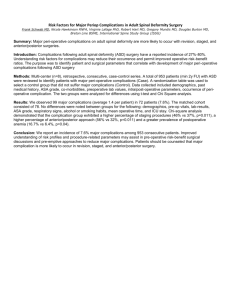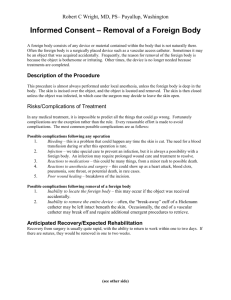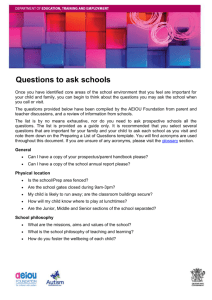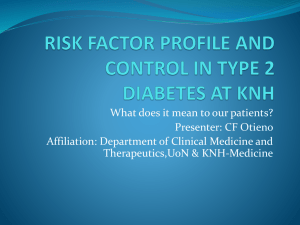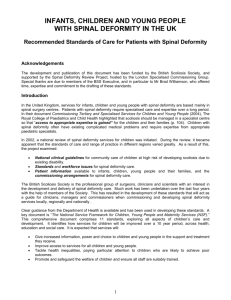TITLE: Major Complications Following Adult Spinal Deformity
advertisement
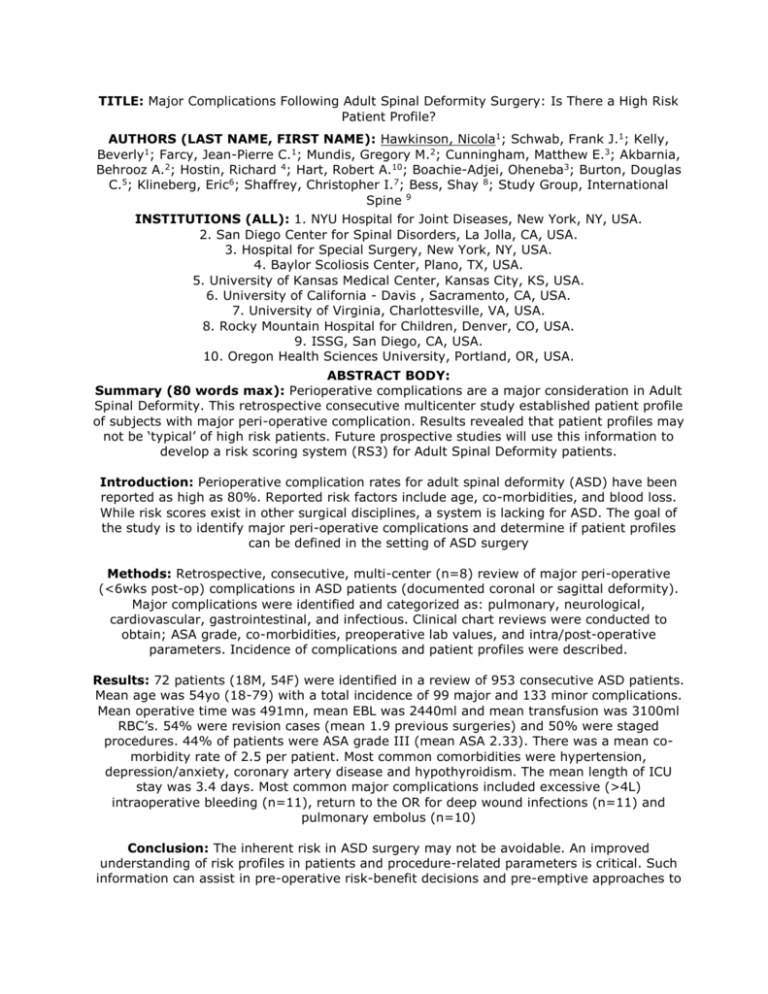
TITLE: Major Complications Following Adult Spinal Deformity Surgery: Is There a High Risk Patient Profile? AUTHORS (LAST NAME, FIRST NAME): Hawkinson, Nicola1; Schwab, Frank J.1; Kelly, Beverly1; Farcy, Jean-Pierre C.1; Mundis, Gregory M.2; Cunningham, Matthew E.3; Akbarnia, Behrooz A.2; Hostin, Richard 4; Hart, Robert A.10; Boachie-Adjei, Oheneba3; Burton, Douglas C.5; Klineberg, Eric6; Shaffrey, Christopher I.7; Bess, Shay 8; Study Group, International Spine 9 INSTITUTIONS (ALL): 1. NYU Hospital for Joint Diseases, New York, NY, USA. 2. San Diego Center for Spinal Disorders, La Jolla, CA, USA. 3. Hospital for Special Surgery, New York, NY, USA. 4. Baylor Scoliosis Center, Plano, TX, USA. 5. University of Kansas Medical Center, Kansas City, KS, USA. 6. University of California - Davis , Sacramento, CA, USA. 7. University of Virginia, Charlottesville, VA, USA. 8. Rocky Mountain Hospital for Children, Denver, CO, USA. 9. ISSG, San Diego, CA, USA. 10. Oregon Health Sciences University, Portland, OR, USA. ABSTRACT BODY: Summary (80 words max): Perioperative complications are a major consideration in Adult Spinal Deformity. This retrospective consecutive multicenter study established patient profile of subjects with major peri-operative complication. Results revealed that patient profiles may not be ‘typical’ of high risk patients. Future prospective studies will use this information to develop a risk scoring system (RS3) for Adult Spinal Deformity patients. Introduction: Perioperative complication rates for adult spinal deformity (ASD) have been reported as high as 80%. Reported risk factors include age, co-morbidities, and blood loss. While risk scores exist in other surgical disciplines, a system is lacking for ASD. The goal of the study is to identify major peri-operative complications and determine if patient profiles can be defined in the setting of ASD surgery Methods: Retrospective, consecutive, multi-center (n=8) review of major peri-operative (<6wks post-op) complications in ASD patients (documented coronal or sagittal deformity). Major complications were identified and categorized as: pulmonary, neurological, cardiovascular, gastrointestinal, and infectious. Clinical chart reviews were conducted to obtain; ASA grade, co-morbidities, preoperative lab values, and intra/post-operative parameters. Incidence of complications and patient profiles were described. Results: 72 patients (18M, 54F) were identified in a review of 953 consecutive ASD patients. Mean age was 54yo (18-79) with a total incidence of 99 major and 133 minor complications. Mean operative time was 491mn, mean EBL was 2440ml and mean transfusion was 3100ml RBC’s. 54% were revision cases (mean 1.9 previous surgeries) and 50% were staged procedures. 44% of patients were ASA grade III (mean ASA 2.33). There was a mean comorbidity rate of 2.5 per patient. Most common comorbidities were hypertension, depression/anxiety, coronary artery disease and hypothyroidism. The mean length of ICU stay was 3.4 days. Most common major complications included excessive (>4L) intraoperative bleeding (n=11), return to the OR for deep wound infections (n=11) and pulmonary embolus (n=10) Conclusion: The inherent risk in ASD surgery may not be avoidable. An improved understanding of risk profiles in patients and procedure-related parameters is critical. Such information can assist in pre-operative risk-benefit decisions and pre-emptive approaches to reduce risk. This study reveals that patients affected by major complications in ASD surgery may not be ‘typical’ high risk patients. This study will form the basis for a prospective multicenter study and aid in the development of a risk scoring system for ASD (RSSS=RS3) Cardiac Arrest Cord Deficit Death Nerve Root Injury Coagulopathy Vessel Organ injury Excessive Bleeding if >4liters Malignant Hyperthermia Bowel/Bladder deficit Death Deep Vein Thrombosis Cauda Equina Deficit Infection deep-return to OR Motor Deficit/ Paralysis Myocardial Infarction Neuropathy Optic Deficit/Blindness Pneumonia Pulmonary Embolism Acute respiratory failure Sepsisi Stroke Acute Respiratory distress Syndrome Cholecystitis Pancreatitis Unplanned return to OR Prolonged ICU stay*greater thank 72 hr i For one or more days after the major operating room procedure code
